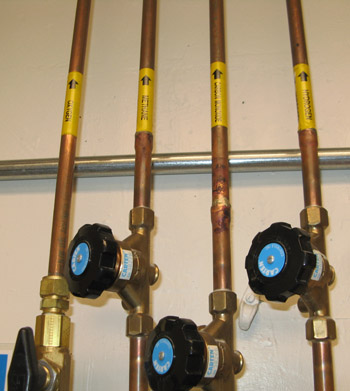Piping Layout and Design
Hydrogen piping systems must be carefully designed and installed to minimize the potential for leaks and allow for their easy detection. Piping systems should be designed in accordance with the applicable codes and standards and to:
- Minimize leaks through the use of welded joints where possible.
- Ensure that personnel will be able to easily reach joints and fittings (to check for leaks).
- Prevent or reduce the chance of personal injury (i.e., contact with cold surfaces, head impact, tripping hazards, etc.).
- Minimize stresses (structural and thermal) in piping components and connected equipment.
- Strive for leak-tight joints.
- Determine proper sizes and settings of pressure relief devices.
- Include properly labeled shutoff valves at safe locations.
Flow restrictors, such as orifice meters, in the supply line are an effective means of limiting the supply flow rate and controlling leakage rate.
Piping should be labeled to indicate content, flow direction, and design and test pressures.
References
ASME B31.3 Process Piping Code is available for purchase online.
CGA G-5.4 - Standard for Hydrogen Piping Systems at Consumer Locations
G-095-2004, ANSI/AIAA Guide to Safety of Hydrogen and Hydrogen Systems, can be purchased from www.aiaa.org.
NFPA 55, Standard for the Storage, Use, and Handling of Compressed Gases and Cryogenic Fluids in Portable and Stationary Containers, Cylinders, and Tanks


